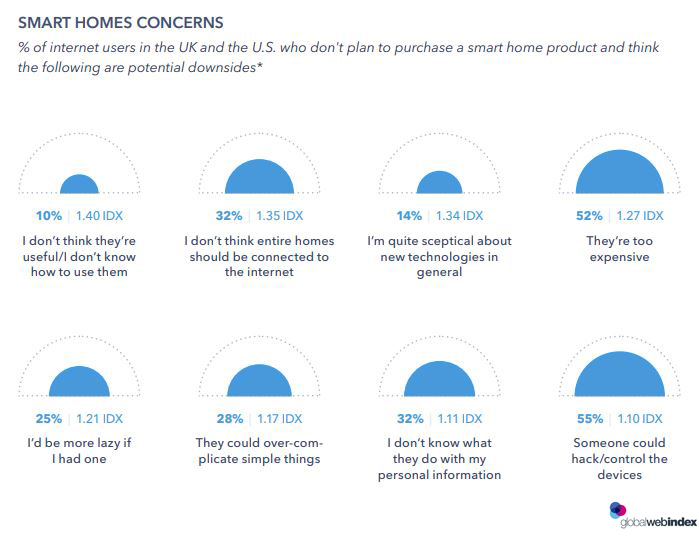The Future of Smart Homes, 2019 Report | GlobalWebIndex
Consumer Behavior | UK
Smart homes and home automation are ambiguous terms used in reference to a wide range of solutions for controlling, monitoring and automating functions in the home. Smart homes and the internet of things IoT are two interconnected trends dating back to the late 1990s-2000s. Without the IoT, the ability of the internet to connect different devices and enable them to send and receive data smart homes would never have been made possible. A smart home is more sketched as home automation or assistive domotic. It refers to the use of computer and information technology to control devices and features in a home-like environment such as lighting, entertainment systems, temperature, and so on. Smart homes use the electronic networking technology to integrate various devices and appliances found in almost all homes so that an entire home can be controlled centrally or remotely as a single machine. Inside each of these machines, integrating all devices and appliances allows them to communicate with one and another through a home controller, thereby simultaneously enabling control of various machines in preprogrammed scenarios or operating modes.
The Key Findings of “The Future of Smart Homes, 2019” Report:
- 12% of internet users globally own a smart home product.
- 66% in the UK and the U.S. reported that they are planning to purchase a smart home product in the next year.
- The USA is ranked as the top market with internet users that owns a smart home product with a rate of 18%.
- 73% of surveyed UK and US internet users reported that they consider buying a smart security camera in the next 12 months.
- 53% of surveyed internet users in the UK and US mentioned that the most motivating factor for buying a smart home product is saving money.
- 32% of surveyed generation Z internet users want to be reassured that their personal information is not used by companies.
- 62% of respondents reported in the UK and the US that they want smart home products to be informative.
- 55% of surveyed internet users in the UK and the US reported that the main barrier of smart home product adoption is that someone could hack/control the devices.
- 40% of surveyed internet users in the UK and US mentioned that they have a lack of knowledge of how these smart home devices can make their lives easier.

A Figure Shows The Main Barriers of Smart Home Devices Adoption, 2019.
The Content of “The Future of Smart Homes, 2019” Report:
- Key Insights.
- The Current Landscape of the Smart Home Market.
- Opportunity and Demand for Smart Home Products.
- What Drives Adoption?
- The Literal Voice of Brands.
- Barriers to Adoption.
- Notes on Methodology.
- More from GlobalWebIndex.
Number of Pages:
- 31.
Pricing:
- Free.
Methodology:
This report is conducted a GlobalWebIndex’s online research among internet users aged 16-64. The interview respondents aged 16-64 and the figures are representative of the online populations of each market, not its total population. The data in this report is taken from a bespoke survey from July 2019 among 2,221 (U.S.) and 2,325 (UK) smart home product intenders aged 16-64.







